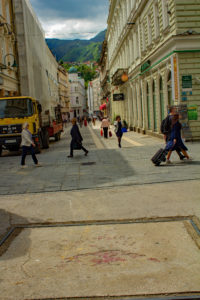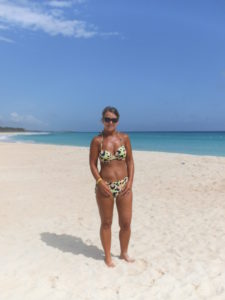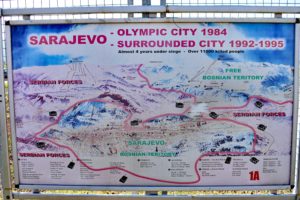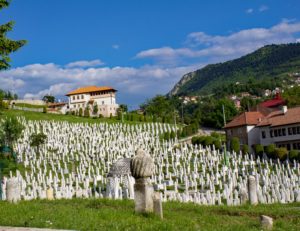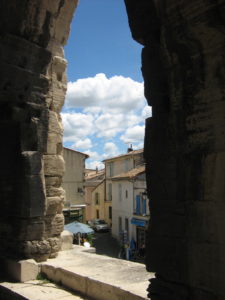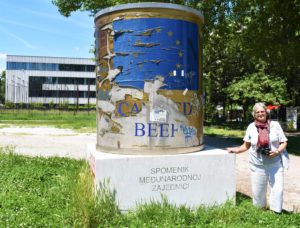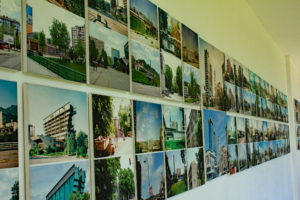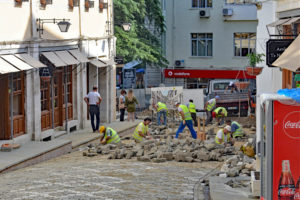The Bosnian War in the early 1990s is well documented and it’s impossible to visit Sarajevo without seeing the impact. Simply walking around allows you to see the many buildings which still retain the scars of missile attacks. Other reminders need to be sought out.
Sniper Alley – A much reported horror of life in the city was the indiscriminate shooting of civilians of all creeds. On our walking tour we passed a simple street which became known as ‘sniper alley’. At the cathedral, we saw the vantage point where snipers would have hidden on the hillside and how people detoured round the back of the Cathedral to avoid them. Sarajevo Roses are sadly everywhere. They are places where bombs or mortars detonated and killed people, who were often simply queuing for food and water. The scars left in the asphalt or pavement have been filled with a resin tinted red to mark the place of the massacres. A specific memorial identifies the spot where the Cellist of Sarajevo played.
Tunnel Museum – a short distance from the city centre we found the Tunel Spasa or Tunnel Museum. During the siege, a 700m tunnel running under the airport was the only way in and out of the city. At the Museum entrance, photography boards depicted life during the siege and ski maps, overlaid with the siege lines, graphically illustrated the change in Sarajevo’s fortunes in only a few years. We watched a short film of people using the tunnel during the siege and helpfully our guide translated for us. An outdoor area showed the various types of landmines used. A series of showcases depicted; a cellar where people would have sheltered, a wood burning stove with a shoe being fed into it, cans of meat dropped by humanitarian forces, cigarettes (a siege currency) and their packets made from newspapers, how batteries were rigged to provide lights, candles etc. In the gift shop, original army ration cans were on sale. We then went Inside the 20-metre stretch of tunnel which was very low and narrow but nowhere near as frightening it must have been in the darker, much longer one, with all the associated horrors and smells of war. We were told that it was designed by a young man who proposed the idea at a meeting and that it was started by digging from the two ends, fortunately they met but one half was 37cm higher.
Sarajevo Memorial Centre Kovaci – A short walk from our hotel we found a huge cemetery spilling out up the hillside, full of the white headstones which sadly abound in Bosnia. There was a central fountain and turbe, or mausoleum and a map denoted where each person was buried. We also found an original graveyard with distinctive Ottoman stones. It was a peaceful spot to wander and reflect on the atrocity and huge loss of life.
ICAR Canned Beef Monument – During the siege, more than 160,000 tonnes of food were air dropped into Sarajevo. However, the ‘food’ was generally either 20-years-out-of-date Vietnam War leftovers, pork-based products which the Muslims couldn’t eat or the infamous ICAR Beef. Locals said the latter was inedible and stories claimed that even stray dogs wouldn’t eat it. But often it was the only food they had. In April 2007, the ICAR Canned Beef Monument appeared. Standing about two meters tall, the statue depicts a giant can of beef and an inscription below sarcastically thanks the international community for their help and aid. Sadly, we found it looking rather tatty with a plinth desecrated by graffiti.
Museums – there are two museums near the Canned Beef Monument. The first, the National Museum, looked a grand place whilst the second, the History Museum of Bosnia and Herzegovina, appeared in a state of disrepair. However, having discovered the entrance and paid our 7 Marks/£3.20, we found our guidebook’s claim that it hosted an excellent and moving permanent exhibition of the siege, was true. At the entrance was a marble statue of three figures called Carry the Wounded: the two soldiers assisting a wounded man was designed to display solidarity and unity. The first room described how life would have been during the siege of Sarajevo with artefacts donated by those who had lived through it – food supplies dropped, oil, stoves fashioned from scrap metal etc. There was a ‘black room’ which warned of grisly images of those killed during the conflict. We sat and listened to audio tapes about people’s experiences and then discovered a large area of artwork in conjunction with Kings College London containing sculptures and portraits of Tito. For me, the highlight was a long wall display of photographs of Sarajevo’s iconic landmarks and buildings taken by a Scottish-born photographer, Jim Marshall, in 1996. He replicated the photographs 15 years later and the two were displayed together. They depicted the enormous amount of reconstruction and demonstrated the resilience of those who’d lived through the siege. The similarities between the images and the care taken to ensure like for like was amazing. Only a few before and after photos looked completely different.
Srebrenica Exhibition – this was a photo exhibition depicting the genocide in Srebrenica. At 12 Marks/£5.50 it was one of the most expensive entrance fees, but I felt another 3 for an audio guide was worthwhile. The striking, stark, large black and white photographs and commentary told how some of the bodies were moved up to five times in an attempt to destroy evidence with some being moved 30 km to the front line to make them look like victims of combat. Some mass graves had been mined and these had to be cleared first before the painful process of identifying the victims could begin. A video told of the genocide and art and posters depicted how the country felt the world had neglected them. It was all very moving and there were two final videos with interviews of two ladies who’d lost all the male members of their families. Finally, a 16m long Wall of Death was inscribed with the names and ages of the 8,372 men killed in Srebrenica and buried in the Srebrenica and Potocari Memorial Centre and Cemetery.
Logavina Street – One of the books we’d read leading up to our trip, was Besieged: Life Under Fire on a Sarajevo Street by Barbara Demick. It told the story of ten ethnically diverse families in Logavina Street during the siege of Sarajevo who for three and a half years often lived without heat, water, food or electricity. We were keen to see the street for ourselves and found a very long, straight and steep road. We sought out the houses and buildings which had been so well described including the police station, lower mosque and pink house. At the top was a second mosque, the orphanage and cemetery, once again, full of white marble headstones. Although there was a gate leading into the cemetery, it was unusually overgrown, and we decided against finding the graves mentioned in the book.
On our second day, we found the Sarajevo brewery which was one of the few sources of water during the siege and where the people of Logavina Street had to fetch water from. It was quite a distance and having to dodge snipers and then carry the water up the hilly street, made the story even more poignant.
This aspect of Sarajevo was emotional and draining, but we felt uplifted by the resilience of the people who lived through such harrowing times.
